The theme of the 2017 YLTSIG Pre-Conference Event (PCE) was Values Education, an area increasingly in the spotlight as we become more globally interconnected. The YLTSIG PCE did more than just showcase Values Education however, it raised delegates’ awareness of what children and teenagers need to be better able to succeed in today’s challenging times. The plenaries and workshops were premised around the ‘whole child’ and promoted positive, inclusive and diverse teaching practices which embrace children’s home languages and cultures. As a YL ELT professional who has long advocated better understanding of our wider educator remit, which extends beyond teaching language, the approaches adopted by the YLTSIG during the PCE resonated strongly with me.
The PCE underlined that YLTSIG members are a group of dedicated professionals up-to-date with the latest trends and research in the YLT community. I left the PCE with a wide range of practical ideas, and highly motivated to use these with my learners as well as share them with my peers. I could not have asked for a better start to my first IATEFL conference experience!
Integrating Values Education into Everyday Classroom Practice (Carol Read, Plenary 1)
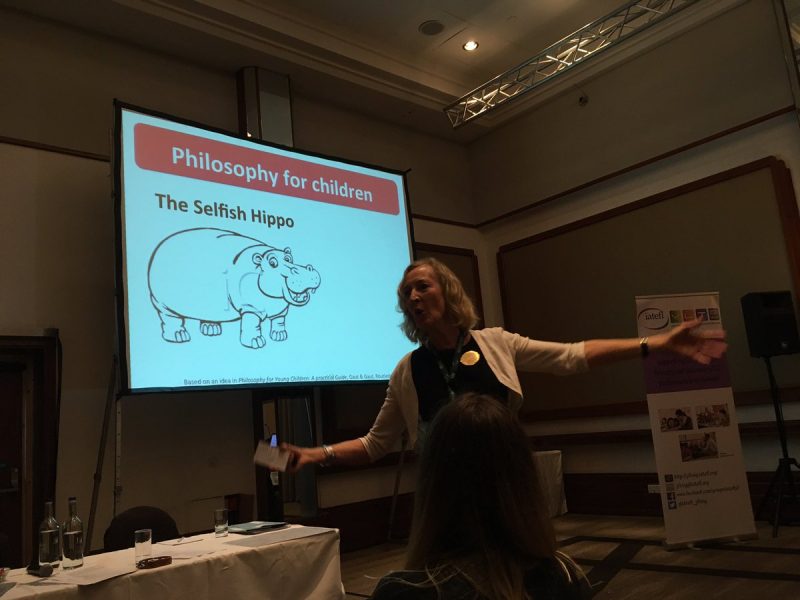 Carol Read’s opening plenary got us thinking straight away. What are values? What is Values Education? With a simple photo of Paddington Bear, the world’s most famous refugee, Carol demonstrated the controversial nature of Values Education. Would Paddington receive the same welcome today? With intolerance and xenophobia sweeping many parts of the world, Values Education is more important than ever, for what is education without values?
Carol Read’s opening plenary got us thinking straight away. What are values? What is Values Education? With a simple photo of Paddington Bear, the world’s most famous refugee, Carol demonstrated the controversial nature of Values Education. Would Paddington receive the same welcome today? With intolerance and xenophobia sweeping many parts of the world, Values Education is more important than ever, for what is education without values?
Carol shared the 3 dimensions involved in values: the self, which includes respect, discipline, control and kindness; others, which includes respect, empathy, tolerance and inclusion; and finally, the environment, which includes respect, care, preservation, safety. This is further complicated if we consider that context determines values. Whose values are we teaching and are they appropriate for the culture and context we are teaching in? Do we, as educators, have a right to impose values? Given that Values Education should be about choice, Carol emphasised the importance of guiding our learners so they are able to make choices about their own values, without jumping in too quickly. Instead, we should enable learners to think and discover for themselves the things that matter to their lives, providing it is age appropriate. She then shared a plethora of practical ways to do this:
- Socialisation: using “please” and “thank you” when interacting in the classroom
- Modelling the value you aim to promote so children can copy this
- Thinking and acting: reflecting on values and understanding why they are adopting them
- Language of values: explicitly teaching children useful language to empower them to talk about values
- Storytelling and picturebooks: as age appropriate vehicles to increase awareness of values
- Drama and role play: to provide learners with a safe environment to rehearse and enact values
- Discussion and personalisation: as children get older this is possible when embedded in an accessible context
- Poetry, songs, rhymes, raps: as springboards to start thinking about values. This awareness may not necessarily lead to behaviour change unless made explicit, however (something for us to think about)
- Cooperative learning: to develop teamwork and establishing positive relationships among peers
- Images: to represent values where learners can list global problems the images depict and then explore possible solutions
- Circle time: where children are equal participants and practise turn taking, seeing each other, and demonstrating respect
- Intercultural awareness: learners observe and compare what they see / hear and then contrast with their own lives
- L1 use: accepting L1 is an important value as it models respect for the children’s own languages and cultures
In summary, Carol’s plenary established why Values Education is crucially important in today’s world. Even though society is made up of individuals, there are shared global values. If we want to provide quality education in our societies, Values Education needs to be at its core. The children we teach are our future; as educators, we have a responsibility to ensure that the classroom environments that we provide allow learners to explore the values and skills they will need to navigate a more interconnected and globalised world, one of diversity and inclusion.
A Global Perspective on 21st Century Values Education (Dr Joan Kang Shin, Plenary 2)
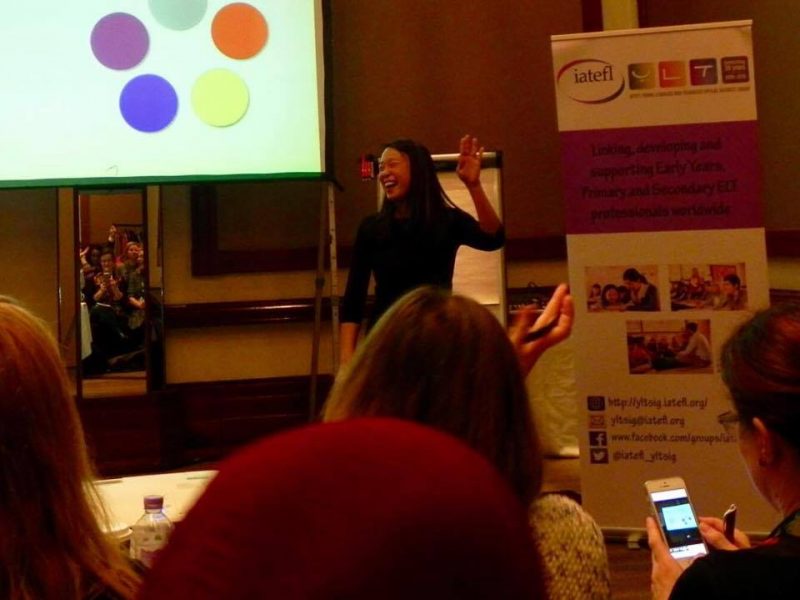 Joan Kang Shin’s plenary took the concept of Values Education and placed it on a global scale. What are global values? Are they universal? Can we take action around global values? As someone with a bicultural background, Joan has first-hand experience of weaving between cultures and languages, which has shaped and formed her own identity. She provided the example of parental / caregiver love to demonstrate the importance of context and culture when discussing and making judgements about global values. In the USA, caregivers raise children to be independent and it is not uncommon for children to leave home after high school. In contrast, South Korean caregivers raise children to be a part of a collective family unit and it is not uncommon for three generations to live together. So not only does it depend on how the value is perceived, but also how this value is actualised will depend on culture. This is where things get complicated – values, priorities, and assumptions are the 90% of the so called cultural iceberg that we cannot see.
Joan Kang Shin’s plenary took the concept of Values Education and placed it on a global scale. What are global values? Are they universal? Can we take action around global values? As someone with a bicultural background, Joan has first-hand experience of weaving between cultures and languages, which has shaped and formed her own identity. She provided the example of parental / caregiver love to demonstrate the importance of context and culture when discussing and making judgements about global values. In the USA, caregivers raise children to be independent and it is not uncommon for children to leave home after high school. In contrast, South Korean caregivers raise children to be a part of a collective family unit and it is not uncommon for three generations to live together. So not only does it depend on how the value is perceived, but also how this value is actualised will depend on culture. This is where things get complicated – values, priorities, and assumptions are the 90% of the so called cultural iceberg that we cannot see.
A tool that can help bring that 90% of the iceberg into sight is Bennett’s Developmental Model of Intercultural Sensitivity (DMIS). It is suggested that awareness and sensitivity are not static, but can be developed and enhanced over time. Its aim is to explain the process of and readiness for accepting cultural differences. As educators, we develop young minds and can positively impact their education if we can equip our learners with the tools to be successful and confident as they make their way through their worlds. One way to do this is by guiding them as they explore worldviews, behaviours and attitudes so that they are more able to accommodate cultural differences. As such we can adopt a systematic approach and use age appropriate techniques to move learners from Ethnocentrism (‘my culture is bigger and more important’) to Enthorelativism (‘cultures are relative to one another within cultural contexts’). According to Joan, too many teachers operate within the third point on the DMIS: minimisation, recognising and accepting superficial cultural differences, basically saying the cultures are the same and as such de-emphasises cultural differences. The take away from this is that we all should reflect more deeply on where we are on the DMIS. You can learn more here: http://meldye.weebly.com/what-is-dmis.html
Joan then provided practical ways to work with the DMIS in lessons, using English as a vehicle to open windows to intercultural learning:
- International Children’s Songs Approach: teachers can draw on the visual aspects of surface culture to gently introduce the concept of cultural differences and similarities to early years and primary aged children. Using international children’s songs and video recordings of children singing these songs around the world enables children to identify with others of a similar age. Visit the Songbirds Facebook group to get involved! https://www.facebook.com/groups/JKSongbirds/
Songbirds is a project developed to bring teachers and children around the world together through children’s songs. Joan uses English as a global language to share popular, traditional children’s songs from diverse languages and cultures. To participate in this project with your learners, follow these steps:
- Choose a traditional children’s song from your culture to share with the world.
- Create an English version that a) keeps the melody and b) retains the meaning / feeling of the song.
- Post a video of your learners singing two versions to the Songbirds Facebook group: a) original song in original language and b) the English version. Ensure you have signed parental / caregiver permission to comply with safeguarding and child protection obligations.
- Post the lyrics in both languages with your video.
Other approaches suggested by Joan include:
- Intercultural comparison: learners compare different cultures to find similarities and differences. Allow for negative statements, so that there is a starting point before moving learners along the DMIS scale. Promote a sense of sharing and taking care of others to model the notion that we are all human first and foremost and together form a part of a wider community, the human family.
- Identify similar values and features: emphasise the differences in how different cultures express and demonstrate a particular value. The first step is to enable children to understand and appreciate their own cultures, as you can only identify differences if you have this information to compare against. Ranking activities that enable learners to explore their feelings and thoughts about diverse ideas are useful for this area.
- Link cultural knowledge to behaviour: encourage children to develop different points of view about the world while affirming their own identities.
Joan’s closing remark was a real eye opener. Up until that point, I’d always believed in the golden rule of treat others the way you want to be treated. However, she flipped this around, demonstrating how we can integrate Values Education in our day to day interactions. She calls it the Platinum Rule: treat others the way they want to be treated. This positions our learners at the heart of their learning: we get to know who they really are and what values they genuinely hold.
Values Education in Young Learner Teacher Training & Development (David Valente, Plenary 3)
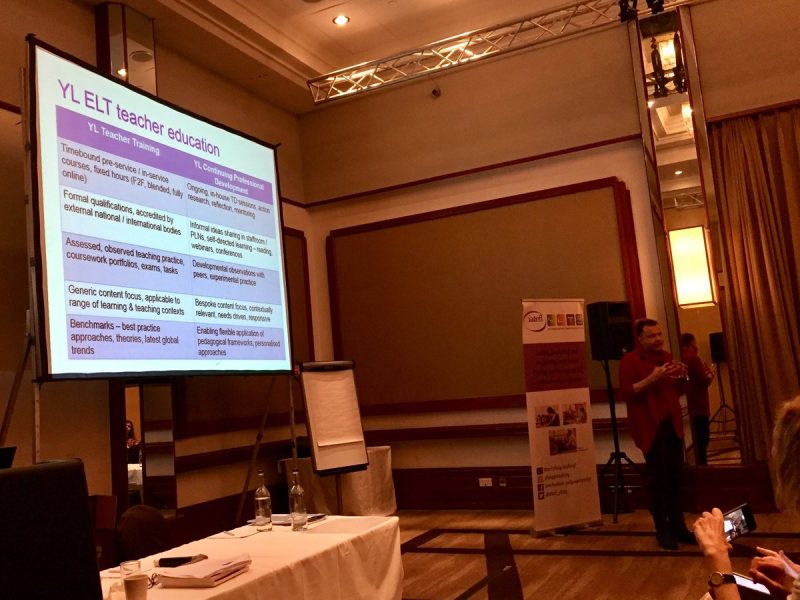 David Valente’s plenary explored another dimension in Values Education, which maintained that if we want YL teachers to embrace and be skilled in embedding Values Education, then this needs to be included in ELT training and development programmes worldwide. He argued how the first obstacle to this is how the term ‘young learners’ is confusingly used as an all-encompassing umbrella to refer to ages 2 – 17 years. David advocated for defining ‘young learners’ more specifically so that we can better enable teachers to teach in age-appropriate ways. Furthermore, we have a responsibility to the teachers we are training to ensure they are equipped with appropriate skills to work with the age groups they are teaching. Teaching an early years learner is very different from teaching an upper secondary student who is about to go to university! Defining these age groups enables teachers to start to approach Values Education in a way that is fully congruent with learners’ life stages.
David Valente’s plenary explored another dimension in Values Education, which maintained that if we want YL teachers to embrace and be skilled in embedding Values Education, then this needs to be included in ELT training and development programmes worldwide. He argued how the first obstacle to this is how the term ‘young learners’ is confusingly used as an all-encompassing umbrella to refer to ages 2 – 17 years. David advocated for defining ‘young learners’ more specifically so that we can better enable teachers to teach in age-appropriate ways. Furthermore, we have a responsibility to the teachers we are training to ensure they are equipped with appropriate skills to work with the age groups they are teaching. Teaching an early years learner is very different from teaching an upper secondary student who is about to go to university! Defining these age groups enables teachers to start to approach Values Education in a way that is fully congruent with learners’ life stages.
The second consideration is to move away from training which only enables teachers to teach language, to a model which clearly balances the roles of being a teacher of language with those of a teacher of children. This links to the whole notion of duty of care and being ‘in loco parentis’.
David went on to exemplify the plethora of internationally recognised training courses currently available for young learner teachers of English: IHCYLT, TKT YL, ICELT, Delta Modules 2 & 3 (specialising in Young Learners), Trinity TYLEC, Nile TEYLs, CiPELT, CiSELT, Celt P and Celt S, to name a few. He challenged delegates to consider which of these are ‘Values Education lite’ and which are in fact ‘Values Education absent’ and his call to action was for trainers and course developers to transform these qualifications into ones which are genuinely ‘Values Education rich’.
He then explored how Values Education themes are now commonplace in ELT coursebooks for children and teenagers but teachers are frequently lacking in confidence as to how to exploit these in their contexts. This is where teacher training and development can play a major transformative role. David illustrated by borrowing the idea of PARSNIP topics which has gained traction in adult ELT in recent years as ways into exploring real world topics in the classroom. He then adapted this for primary ELT to offer suggestions for age appropriate Values Education themes:
- P: positive thoughts and words
- A: age and abilities
- R: religions, ethnicities and cultures
- S: sharing with classmates
- N: neighbours and communities
- I: individuality and interests
- P: peace and kindness
With robust training and development, teachers can integrate these Values Education areas in their lessons providing they receive plenty of contextually relevant mentoring and support. He drew on ideas from Emily Hird’s work to illustrate practical ideas for training teachers to use in Values Education themed lessons:
- storytelling to develop empathy
- sharing personal ideas and experiences
- establishing a class values motto
- creating and using kindness calendars
- researching local charities
- developing conservation projects for environmental awareness
- involving diverse families during project work
- establishing a monthly values wall display
- making intercultural links to learners around the world who are the same age via child safe online exchange programmes
- modelling a values-rich culture
In summary, David emphasised the urgent need for YL ELT teacher education to actively promote Values Education and inspire teachers to incorporate this in their everyday teaching. If teacher trainers aim to meet the needs of their trainees, then we require a tangible shift from a tendency to focus on abstract theory. Instead, teacher educators need to use the classroom as a starting point so that the context for embedding Values Education is directly relevant. He ended by stressing that in order to have sustainable, long term impact, trainee teachers need to see ‘relatable models’ of peers incorporating Values Education in the classroom during all YL ELT training and development programmes.
Accountability & Resilience: Values that Develop Learning (Gail Ellis & Nayr Ibrahim, Workshop 1)
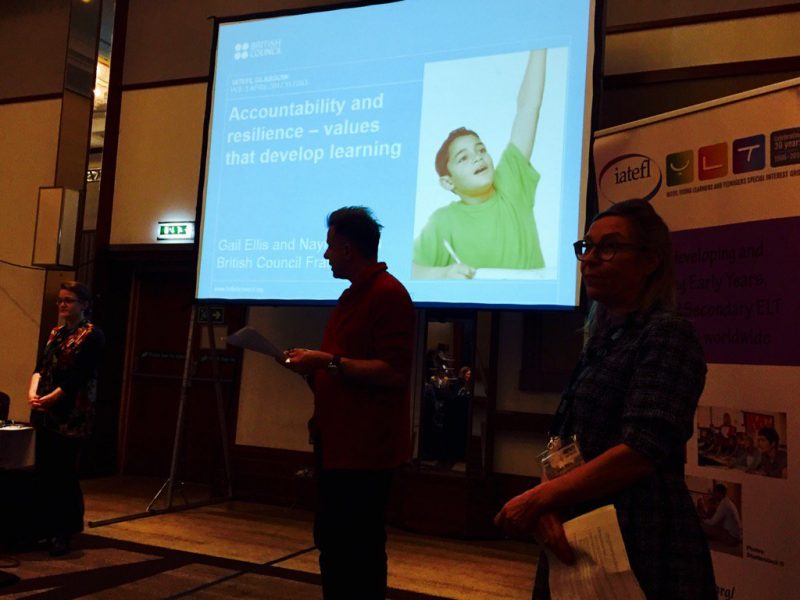 This practical workshop focused on the values of accountability and resilience, fundamental to a Values Education approach as they empower children to take responsibility for their learning (accountability) as well as providing the necessary tools to keep going despite setbacks (resilience). Gail Ellis defined accountability to include maximising learning, taking ownership and achieving personal goals, thus placing children at the centre of their learning experience. An important factor of accountability is the concept of teachers being accountable for the learners’ learning. This could take the form of informing and reporting to parents / caregivers, collaborating with other teachers to provide a whole school approach and so on. By developing learners’ accountability, teachers help children take responsibility for their learning, which enables them to experience more success as they have control and choice. They become more proactive and can reach higher levels of achievement through hard work and perseverance. Gail listed 4 steps to accountability:
This practical workshop focused on the values of accountability and resilience, fundamental to a Values Education approach as they empower children to take responsibility for their learning (accountability) as well as providing the necessary tools to keep going despite setbacks (resilience). Gail Ellis defined accountability to include maximising learning, taking ownership and achieving personal goals, thus placing children at the centre of their learning experience. An important factor of accountability is the concept of teachers being accountable for the learners’ learning. This could take the form of informing and reporting to parents / caregivers, collaborating with other teachers to provide a whole school approach and so on. By developing learners’ accountability, teachers help children take responsibility for their learning, which enables them to experience more success as they have control and choice. They become more proactive and can reach higher levels of achievement through hard work and perseverance. Gail listed 4 steps to accountability:
- See it: present the topic / learning goal and give opportunities for children to ask if they don’t understand
- Own it: children practise manipulating and personalising the language using their own words and methods
- Solve it: if children are met with a problem, they consider ways to solve it
- Do it: use success criteria in class to help children become aware of where they are in relation to the required level and then look for ways to enable them reach this
Nayr Ibrahim opened with an easy way to remember the definition for resilience: how well we can bounce! Resilience defines the strategies and coping mechanisms we use in difficult and stressful situations. The need here is for teachers to work on building resilience while maintaining a safe environment for children and their overall well-being. As humans, we all need to feel significant, competent and loved, when this is absent, reactions tend to be angry and result in giving up. As such, the teacher’s role is crucial in the classroom: we are a key positive role model to follow. Empathy and meaningful praise about the effort and work produced will help children to develop a growth mindset. One important point is that children must experience success after a difficult problem, otherwise they won’t develop a growth mindset. Nayr identified 4 key elements for building resilience:
- I belong in this classroom community
- My ability and skills grow with my effort
- I can succeed at this
- This work has value for me
These can then be developed in the ELT classroom via:
- Craftwork, portfolios, scrapbooks that children can work on at their own levels of ability, take pride in talking about their work in class with peers and the teacher, share it with parents / caregivers to develop the accountability triangle of student-home-school
- Create opportunities for children to learn new skills by varying activities and approaches and by assigning different roles in the classroom
- Turn errors into learning opportunities by exploring why it’s wrong, how learners could say it in a different way, identifying where they need more help
- Allow for risk-taking in a safe environment by praising the efforts and contributions of the class and by encouraging children to have a go even if they aren’t sure
Respect & Acceptance: Valuing Differences Inside & Outside the Classroom (Liz Hibberd, Workshop 2)
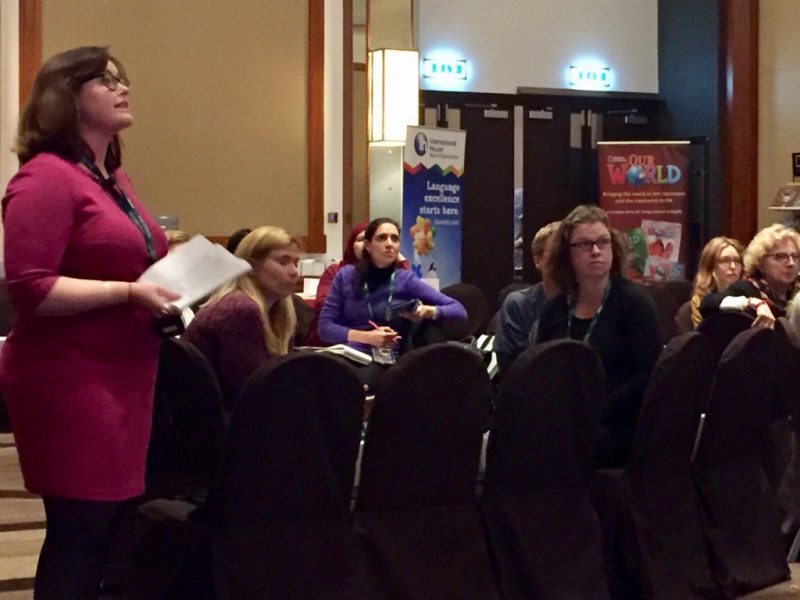 Liz Hibberd’s practical workshop explored the concepts of respect and acceptance within an educational setting. Liz defined respect as holding someone, their actions or ideas, in high regard and esteem, and acceptance as taking someone as they are without trying to change them, their views or beliefs. Within these definitions was the central idea of ‘difference’. This is important, because while we often celebrate our individuality, it is also crucial to highlight and embrace the commonalities we share.
Liz Hibberd’s practical workshop explored the concepts of respect and acceptance within an educational setting. Liz defined respect as holding someone, their actions or ideas, in high regard and esteem, and acceptance as taking someone as they are without trying to change them, their views or beliefs. Within these definitions was the central idea of ‘difference’. This is important, because while we often celebrate our individuality, it is also crucial to highlight and embrace the commonalities we share.
Schools and classrooms represent bubbles of real life, and as such, without the presence of either respect or acceptance, these present barriers to learning. One example is a non-traditional family who may feel isolated or ostracised which may result in children being prevented from accessing essential language education. Another barrier that is often in the news headlines is bullying. Promoting tolerance is not enough to avoid or reduce bullying, it is essential that inclusion and integration are actively promoted in class, and differences are seen in a positive light. As such, these concepts should be included in ELT curricula and programmes to cater for the whole child and safeguard their well-being.
Liz drew on the ICE Framework to identify activities that teachers can use in class to explore respect and acceptance:
Implicit
- Select materials which represent the diversity of the learners in your classes
- Send letters home to families to encourage participation in school activities
- Use songs and videos from different countries and cultures
- Use multicultural posters to decorate the classroom, and to set the context to Values Education themes and topics
Curriculum
- Embed the concepts of respect and acceptance into the curriculum so that they become a natural part of English teaching and not a token extra. Ideally this should be a whole school approach, with easily-accessible, age appropriate materials for all teachers to work with
Explicit
- Activities and tasks which directly facilitate understanding of identity
- Role plays where learners need to view experiences through another lens
- Incorporate age appropriate debates for teenagers and hot seating for primary children
- Draw on aspects of ‘Philosophy for Children’ approaches to provide meaningful opportunities for learners to engage more directly with issues such as discrimination in an age accessible manner. For more information, visit http://www.sapere.org.uk
In summary
Values Education is essential for YLTSIG members as we work directly with the children who will become the adults of the future. The YLTSIG PCE provided delegates with powerful reasons as to why Values Education needs to be incorporated in our lessons, each plenary and workshop added its own unique contribution to the topic and expanded delegates’ horizons. We were also given lots of practical take aways to incorporate this new learning in our classrooms, staffrooms and virtual learning spaces.
For me, the PCE did much more than that, it motivated me to want to give something back to the YL ELT community, and this was the real strength of the event: energising teachers to be passionate about their job, their learners and their schools. I’d like to end this post with a quote from Carol Read’s final slide, “Values Education enriches language learning and has a positive impact on children’s wellbeing, academic diligence and behaviour. It might just also help to change the world!”
And that is something I would very much like to be a part of.


Thanks so much for your comment. I really enjoyed your session, it was a great way to start the day. And yeah, I am quite enthusiastic when it comes to YLT 😀
Thanks for your comment. I’m glad you found this post useful. The theme of Values Education was an excellent choice for the PCE as it really helped us teachers get a better sense of what it involves and how we can bring it into the class.
Thanks so much for your message. It was great to meet you and share ideas, did you get my email with the resources? I hope your bosses find all the material and this post useful 🙂
Thanks so much for writing this up, Shay. It’s a really useful and detailed account of the day – and great the way your enthusiasm shines through too!
I could not attend the conference so your summary here has really helped me get a better idea of what each session focused on. Thanks a lot Shay 🙂
Lovely summary Shay. I also found the YL Sig day very inspiring. It’s taken me a while to process the week and your post is a perfect summary. I need to present to the bosses where I work a summary so I will share this with them. Thank you ?